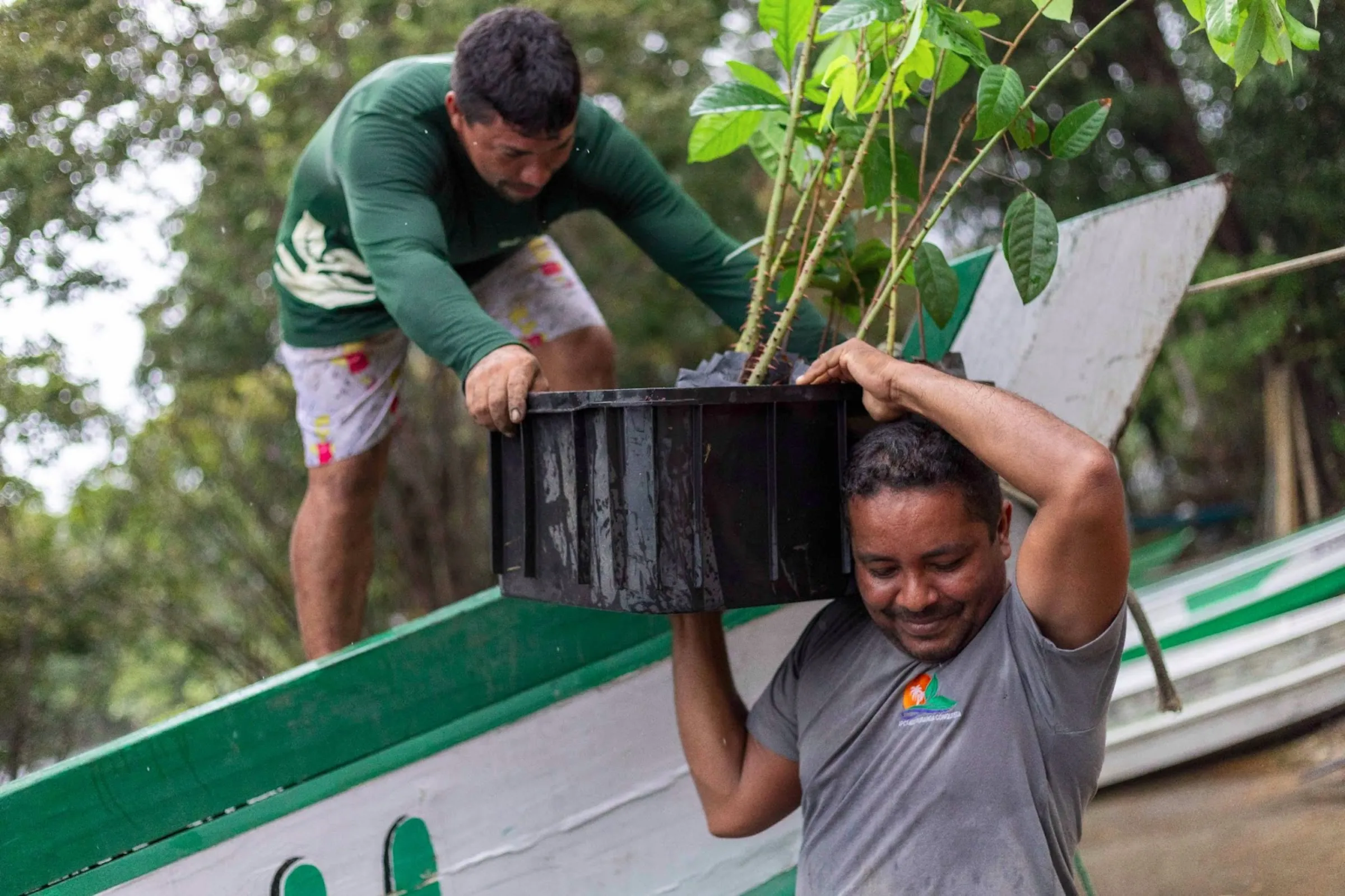Context is powered by the Thomson Reuters Foundation Newsroom.
Our Standards: Thomson Reuters Trust Principles

Agents from a reforestation project from NGO IPÊ disembark with tree seedlings in RDS Puranga Conquista, Manaus, Brazil, March 13, 2025. Nathalie Brasil/Thomson Reuters Foundation
Brazil's conservation mosaics seek to combine regional development with forest conservation.
RDS PURANGA CONQUISTA - From the riverside settlement of Puranga Conquista in the Amazon rainforest, Elisângela Borges ships lotions, soaps, shampoos and oils from her own line of products to faraway cities in Brazil, India and the United States.
Speaking on her porch by the Negro River, Borges said her company, Yara Amazonas, started a partnership with loggers to extract oils and seeds from the forest, instead of cutting trees down.
"The forest pays much more when it is standing," Borges told Context.
Yara Amazonas is just one of dozens of sustainable initiatives within the Lower Negro River mosaic of protected areas, a group of 14 conservation areas established between 1980 and 2018, covering an area larger than Ireland.
The federal government set up the mosaic system in 2000 to better manage contiguous or overlapping natural reserves and to empower communities that live there, said Henrique Pereira, a professor at the National Institute of Amazonian Research.
Made up of community members and federal, state and municipal administrators, the councils that run Brazil's 27 mosaics help tackle land-grabbers, loggers and illegal farmers, and allow funding to trickle down to initiatives on the ground.
The management of public natural areas, from national parks, with strict rules barring people living there, to Indigenous territories and settlements for sustainable development, is a monumental task in Brazil.
These areas make up about 40% of the country's territory, an area larger than India, according to a 2024 government assessment, and are governed by a variety of rules and jurisdictions.
Brazil is preparing to host the COP30 U.N. climate change conference in the Amazon city of Belém in November, raising expectations of new funding and action to protect the country's natural environment while also helping communities.
A severe drought in the Amazon has fueled food insecurity, Brazilian authorities say, as well as wildfires that made a major contribution to record global forest loss last year, according to a report published last month by environmental NGO World Resources Institute.
Scientists say deforestation is compounding the effects of climate change, threatening to turn large areas of the Amazon into drier, degraded ecosystems.
The mix of mosaic council members helps them exchange experiences and gather strength to ensure that conservation efforts on paper are effective on the ground, said Marcos Pinheiro, coordinator of the Network of Mosaics of Protected Areas (REMAP).
Home to more than 800 families, according to a 2024 census, including members of two Indigenous nations, Puranga Conquista is an 86,000-hectare area known as a sustainable development reserve that is part of the Lower Negro River Mosaic.
To get there from Manaus, capital of the state of Amazonas, where most of the Lower Negro River Mosaic is located, takes an hour-long boat trip along the Negro River, flanked by lush rainforest and a few wooden houses.
Settlers are assigned batches of land and are allowed to cultivate crops, fish, and extract seeds, fruit and timber under strict environmental rules and a communally agreed plan.
But it has not always been this way.
When the area was first protected in 1995, Puranga Conquista was classified as part of a state park and human settlement was banned.
People who had lived there for decades could have been expelled, said community leader Francisco Borges, Elisângela's father and a member of the mosaic's council.
In 2000, the community began a campaign with support from other parts of the mosaic that succeeded in 2014 in persuading authorities to reclassify the area as a sustainable development reserve, so people could keep living there.
"Politically, a demand from the mosaic's council is much stronger than a request from a single reserve," said Francisco Borges.
In 2018, the Lower Negro River Mosaic gained another 580,000 hectares, after communities successfully lobbied to have an unprotected area recognized as a sustainable settlement.
Environmentalists say securing communal land rights is key to halting deforestation, as it discourages people from clearing public forests and claiming the land as private farms.
The Amazon Fund, an international mechanism to support projects that halt and reverse deforestation, has helped fund production by Yara Amazonas and three workshops used by local Indigenous people to produce handicrafts.
There are numerous other initiatives within the Lower River Negro Mosaic, including youth groups, fire brigades, furniture workshops and preserving turtle populations.
But these initiatives have not always had political support.
Pinheiro, from REMAP, said many conservation mosaics had helped to keep communities engaged in territorial protection during times of political turmoil.
Between 2019 and 2022, the far-right government of President Jair Bolsonaro oversaw a rise in deforestation in Brazil, as it dismantled environmental policies.
But the Lower River Negro Mosaic council continued to function under the radar.
"They understood it was a storm passing through, so everybody kept gathering quietly," Pinheiro said.
The political challenges, however, have not gone away.
A bill is currently making its way through parliament that loosens the rules governing environmental licensing.
Brazil's powerful agribusinesses support the change, but environmental NGO Instituto Socioambiental said it would allow developers to largely disregard the impact of roads, railways, hydropower dams and other projects on protected areas.
Elisângela Borges said Brazil had vast untapped potential to foster development without harming nature.
"We started with an investment of just 120 reais and now we are showing what the reserve is capable of," she said. "Nature brought me this - it is liberating."
($1 = 5.6892 reais)
(Reporting by Andre Cabette Fabio; Editing by Jack Graham and Jon Hemming)
Context is powered by the Thomson Reuters Foundation Newsroom.
Our Standards: Thomson Reuters Trust Principles